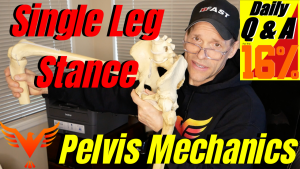My @neurocoffee is perfect as usual, and I have a Q&A that came from yesterday’s call with The Intensive Group about knee pain. Typically, with either medial or lateral knee pain we’ll see a loss of relative motion in the segments of the lower extremity. When segments move together, different aspects of the system will […]
IFAST PT
Q & A for The 16% – Powerlifting Squat vs. Body Weight Squat
My @neurocoffee is on another level today, so here’s today’s Q & A. From SanD: Can you please use your pelvis model to explain/compare pelvic position for stages of a reg squat v. competition back squat? Stuck trying to understand how the reg squat inhale down (sacrum counternutates, ilia spread, pelvic floor/guts drop) to yield, […]
Q & A for The 16% – Single Leg Stance – Pelvis Mechanics
I have my @neurocoffee in hand and here’s today’s Q&A. From Mikheal: If someone is standing on one leg (left) and another leg is flexed in hip and knee 90/90 then the standing leg’s hip is excessively externaly rotated abducted and extended. Why is it and what to do with it? This one is all […]
Q & A for The 16% – The Squat – Body Weight Squats vs. Loaded Squats
My @neurocoffee is in high gear for this morning’s Q & A. From Mihail: Could you please explain how do the mechanics change between a body weight squat and a weighted squat? Wow… what a great question. Lots to unpack here. Be sure to ask questions! #backsquat #bodyweightsquat #billhartmanpt Find Bill: Instagram Facebook Twitter LinkedIn
Q & A for The 16% – Range of Motion Interpretation Mistakes
I get a lot of questions as to how I interpret table tests, and how I relate the results of them to representations of the archetypes, symmetry or asymmetry, and what interventions are best. Your chessboard (the compilation of all your table measures) produces a 4D representation of your client in space. This guides your […]




